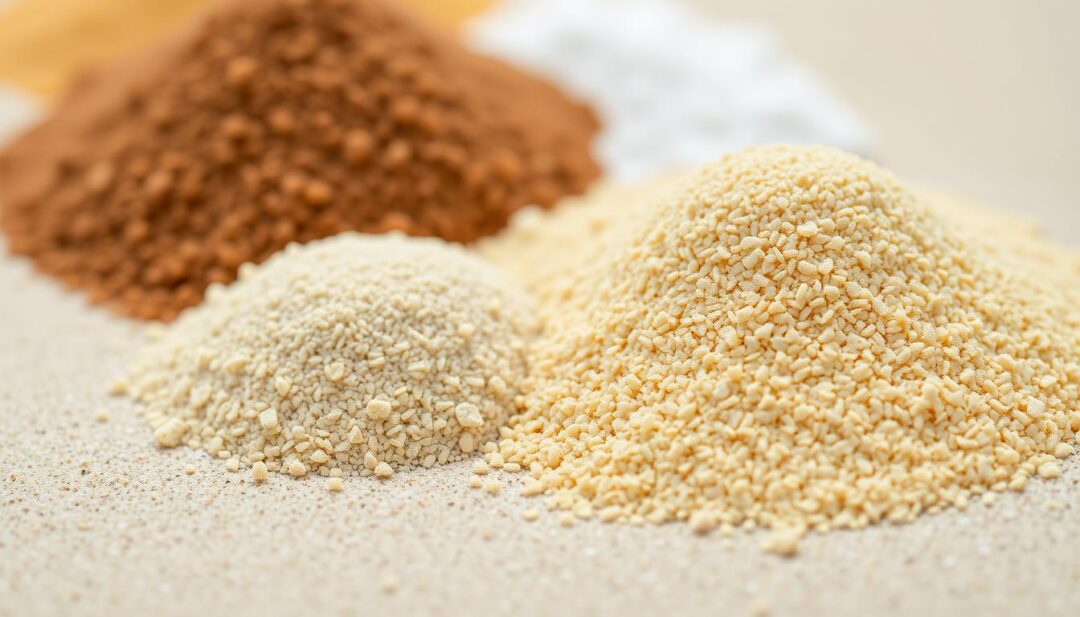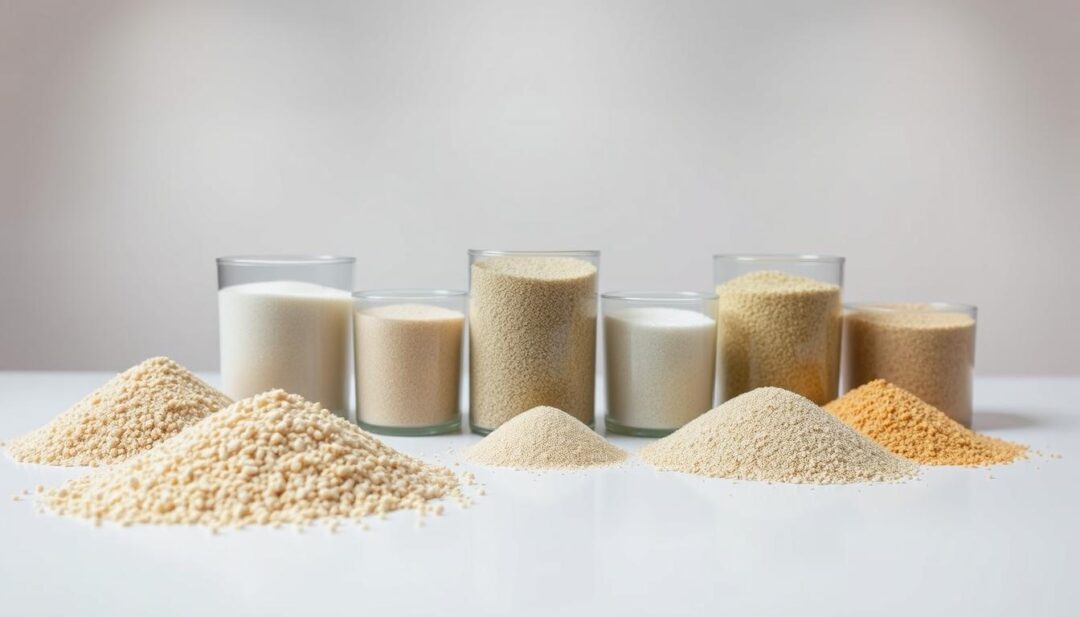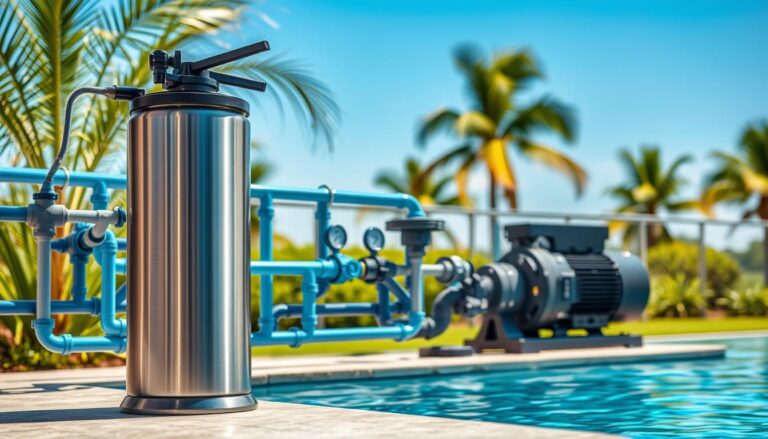What Sand Should I Put in My Pool Filter?
Are you struggling to keep your pool water crystal clear? The secret lies in choosing the right sand for your pool filter. With numerous options available, selecting the best sand can be overwhelming.
The type of sand used in your pool filter plays a crucial role in maintaining clean and clear water. Using the wrong sand can lead to poor filtration, increased maintenance costs, and even damage to your pool equipment. So, how do you choose the right sand?
Understanding the different types of sand and their characteristics is essential. Factors such as grain size, shape, and material composition all impact the effectiveness of your pool filter.
Key Takeaways
- Choose the right sand type for optimal filtration.
- Consider grain size and shape for better performance.
- Regular maintenance is crucial for extending filter life.
- Using the wrong sand can damage your pool equipment.
- High-quality sand improves water clarity and reduces costs.
Understanding Pool Sand Filters
Understanding how pool sand filters work is essential for maintaining a clean and healthy swimming environment. Pool sand filters are designed to remove dirt and debris from the water, ensuring it remains clean and safe for swimmers.
How Sand Filters Work
Sand filters operate on a simple principle: they use a bed of specially designed sand to filter out impurities from the pool water. As the water flows through the sand, dirt and debris are trapped, allowing clean water to pass through. The sand used in these filters is typically made of silica, which is chosen for its effectiveness in filtering out small particles.
The sand filter’s efficiency is largely dependent on the size and quality of the sand grains. The ideal sand should have a uniform size to ensure optimal filtration. If the sand grains are too small, they may pass through the filter grid and into the pool. Conversely, if they are too large, they may not capture smaller impurities.
The Filtration Process Explained
The filtration process in a sand filter involves several key steps. First, the pool water is pumped into the filter tank. As it flows through the sand, impurities are trapped, and clean water is allowed to pass through to the other side. The filtered water is then returned to the pool, leaving behind dirt and debris.
To illustrate the effectiveness of different pool filter sand types, consider the following comparison:
| Sand Type | Filtration Efficiency | Cost |
|---|---|---|
| Silica Sand | High | Moderate |
| Glass Filter Media | Very High | Higher |
| Zeolite Sand | High | Moderate |
Choosing the right pool filter sand is crucial for optimal filtration performance. Factors such as the type of sand, its grain size, and the filter’s design all play a role in determining the overall efficiency of the filtration system.
What Sand to Put in Pool Filter: The Basics
Choosing the right sand for your pool filter is crucial for maintaining clean and safe water. The sand used in pool filters plays a vital role in removing dirt and debris from the water, ensuring a healthy swimming environment.
Standard Pool Filter Sand Specifications
Pool filter sand is specifically designed to meet certain standards for effective filtration. The sand should have a specific particle size and grading to ensure optimal performance. Typically, pool filter sand is made from silica, which is durable and effective at filtering out small particles.
The standard specifications for pool filter sand include:
- A specific grain size, usually between 0.45 and 0.55 mm
- A uniformity coefficient to ensure consistent filtration
- High silica content for durability
When selecting pool filter sand, it’s essential to check the specifications to ensure they meet your filter’s requirements.
Why Not All Sand Is Suitable
Not all types of sand are suitable for use in pool filters. Using the wrong type of sand can lead to poor filtration, increased maintenance, and potentially damage your filter.
Dangers of Using Play Sand or Beach Sand
Play sand or beach sand is not designed for pool filtration and can cause problems. These types of sand are often too fine or too coarse and may contain contaminants that can cloud the water or clog the filter.
Using play sand or beach sand can lead to:
- Poor water clarity
- Increased pressure on the filter
- Potential damage to the filter system
Impact of Incorrect Sand on Filter Performance
The incorrect sand can significantly impact the performance of your pool filter. If the sand is too fine, it may pass through the filter, causing cloudy water. If it’s too coarse, it may not filter effectively, allowing dirt and debris to remain in the water.
Using the correct sand ensures:
- Efficient filtration
- Reduced maintenance
- Longer filter lifespan
Types of Pool Filter Sand Available
When it comes to choosing the right pool filter sand, understanding the different types available is crucial for optimal pool performance. The type of sand you choose can significantly affect the cleanliness and clarity of your pool water.
Silica Sand
Silica sand is one of the most commonly used types of pool filter sand. It’s known for its effectiveness in filtering out small particles and its relatively low cost.
#20 Silica Sand
#20 silica sand is a popular choice among pool owners due to its fine grain size, which allows for effective filtration. It’s suitable for most pool filters and is generally easy to find.
Premium Grade Silica
Premium grade silica sand offers even finer filtration capabilities than #20 silica sand. It’s designed for high-performance pool filters and can provide cleaner pool water.
Glass Filter Media
Glass filter media is an alternative to traditional silica sand. It’s made from recycled glass and offers several advantages, including improved filtration efficiency and reduced maintenance.
- Environmentally friendly
- Less prone to channeling
- Can be more cost-effective in the long run
Zeolite Sand
Zeolite sand is a natural mineral that’s gaining popularity as a pool filter media. It’s known for its ability to remove impurities and odors from pool water.
Key benefits of zeolite sand include:
- Effective removal of ammonia and other contaminants
- Can help reduce algae growth
- Naturally occurring and non-toxic

In conclusion, the choice of pool filter sand depends on several factors, including your pool’s specific needs, budget, and personal preferences. By understanding the different types of pool filter sand available, you can make an informed decision that ensures your pool remains clean and safe for use.
Pool Filter Sand Grading and Particle Size
To ensure your pool water remains crystal clear, it’s essential to understand the importance of pool filter sand grading and its particle size. The effectiveness of your pool’s filtration system heavily relies on these factors.
Understanding Sand Grading Systems
The grading of pool filter sand refers to the distribution of particle sizes within the sand. This grading is crucial because it determines how well the sand can filter out dirt and debris from the pool water.
Mesh Size Explained
The mesh size of the sand indicates the number of openings per square inch of the sieve used to grade the sand. A higher mesh number means smaller particles can pass through, indicating finer sand. For pool filters, the ideal mesh size typically ranges between 20 and 40.
Effective Size and Uniformity Coefficient
The effective size of the sand is the diameter of the particles that allow 10% of the sand to pass through a sieve. The uniformity coefficient, on the other hand, measures the consistency of the particle sizes. A lower uniformity coefficient indicates more uniform particles, which is desirable for efficient filtration.
Optimal Particle Size for Filtration
The optimal particle size for pool filter sand is a balance between being fine enough to capture small debris and coarse enough to allow for good water flow. Typically, the ideal particle size ranges from 0.3 to 0.5 millimeters in diameter. Using sand with the optimal particle size ensures that your pool water is filtered effectively without significantly reducing water circulation.
Key Considerations for Pool Filter Sand:
- Ensure the sand is specifically designed for pool filters.
- Check the manufacturer’s recommendations for mesh size and particle diameter.
- Regularly inspect and maintain your pool filter to ensure optimal performance.
Best Sand for Pool Filter: Top Recommendations
The right pool filter sand can make all the difference in your pool’s water quality. With numerous options available, selecting the best sand for your pool filter can be overwhelming. In this section, we’ll explore top recommendations for pool filter sand, including premium silica sand options, alternative media, and budget-friendly choices.
Premium Silica Sand Options
Silica sand remains the most popular choice for pool filters due to its effectiveness and durability. Premium silica sand is known for its high silica content and uniform particle size, which provides excellent filtration. Brands like Fairmount Water Solutions and US Silica offer high-quality silica sand that can effectively filter out particles as small as 20 microns.
Alternative Media Recommendations
For those looking for alternatives to traditional silica sand, options like glass filter media and zeolite sand are gaining popularity. Glass filter media, such as Aquasol, offers superior filtration capabilities and is environmentally friendly. Zeolite sand is another alternative that not only filters well but also helps in reducing nutrient levels in the pool water, potentially decreasing algae growth.
Budget-Friendly Choices
If you’re on a budget, there are still effective options available. Some pool owners opt for locally sourced silica sand as a cost-effective alternative. However, it’s crucial to ensure that the sand meets the required specifications for pool filter sand to maintain water quality.
Where to Purchase Quality Filter Sand
You can find quality pool filter sand at pool supply stores or online retailers. When purchasing online, look for reputable sellers that provide detailed product specifications and customer reviews to ensure you’re getting the best product for your needs.
How to Choose Pool Filter Sand
To ensure optimal pool performance, it’s vital to understand how to choose the correct pool filter sand. Selecting the right sand involves considering several factors, including your filter model, pool size, and environmental conditions.
Matching Sand to Your Filter Model
The first step in choosing pool filter sand is to ensure it’s compatible with your filter model. Different filters require specific types of sand, so it’s essential to consult your filter’s manual or manufacturer’s website for recommendations. For instance, some filters may require silica sand, while others might be compatible with alternative media like glass or zeolite. You can find more information on compatible filter sand on websites like InTheSwim.
Pool Size Considerations
The size of your pool also plays a significant role in determining the right amount and type of filter sand. Larger pools require more sand to effectively filter the water. It’s crucial to calculate the correct amount of sand needed based on your pool’s volume and the filter’s specifications. Using too little sand can lead to poor filtration, while using too much can cause pressure issues.
Climate and Environmental Factors
Climate and environmental conditions can significantly impact your pool’s filtration needs. For example, pools in areas with high levels of dust, pollen, or other contaminants may require more efficient filter media. Additionally, indoor and outdoor pools have different considerations due to varying environmental exposures.
Considerations for Indoor vs. Outdoor Pools
Indoor pools tend to have fewer environmental contaminants compared to outdoor pools, which are exposed to leaves, dust, and other debris. Outdoor pools may benefit from more robust filter media that can handle higher levels of contaminants.
Regional Water Quality Impact
Regional water quality can also affect your choice of filter sand. Areas with hard water or high mineral content may require specialized filter media to prevent scaling and maintain water clarity.

| Filter Type | Recommended Sand Type | Pool Size Consideration |
|---|---|---|
| Silica Sand Filter | Silica Sand | Small to Medium Pools |
| Glass Filter Media | Glass Media | Medium to Large Pools |
| Zeolite Sand Filter | Zeolite Sand | Pools with High Contaminant Levels |
By considering these factors and choosing the appropriate pool filter sand, you can ensure your pool remains clean, clear, and safe for use. Regular maintenance and monitoring of your pool’s filtration system will also help extend its lifespan and efficiency.
Installing New Sand in Your Pool Filter
To keep your pool in top condition, understanding how to install new sand in your pool filter is essential. This process, while seemingly complex, can be broken down into manageable steps that ensure your pool water remains clean and clear.
Step-by-Step Installation Guide
Tools and Materials Needed
Before starting, gather the necessary tools and materials. You’ll need a new supply of pool filter sand, a scoop or shovel, and potentially a garden hose for rinsing. Ensure you have a compatible replacement sand that meets the specifications of your pool filter.
Removal of Old Sand
Begin by turning off the pump and relieving the pressure. Then, open the filter tank and carefully remove the old sand, taking note to dispose of it properly. It’s crucial to remove all the old sand to prevent contamination with the new sand.
Adding New Sand Properly
Once the filter tank is empty, you can add the new sand. Pour it in slowly and evenly to ensure a uniform layer. The manufacturer’s instructions will typically specify the correct amount to use based on your filter’s size.
Common Installation Mistakes to Avoid
When installing new sand, there are several common mistakes to watch out for:
- Not removing all the old sand, which can mix with the new sand and reduce efficiency.
- Not following the manufacturer’s guidelines for the amount of sand to use.
- Failing to inspect the filter tank for any damage or debris before adding new sand.
By avoiding these mistakes, you can ensure a successful installation that keeps your pool water clean and your filter operating efficiently.
Troubleshooting Sand Filter Problems
Troubleshooting your sand filter can be a straightforward process if you know what to look for. Sand filters are essential for maintaining clean and safe pool water, but they can sometimes encounter issues that affect their performance.
Common problems with sand filters include sand channeling, cloudy water after sand replacement, and pressure issues. Let’s explore these problems and their solutions.
Sand Channeling Issues
Sand channeling occurs when the sand in the filter becomes compacted, creating channels for water to flow through without being properly filtered. To resolve this issue, you can try backwashing the filter to loosen the sand. If the problem persists, it may be necessary to replace the sand entirely.
Cloudy Water After Sand Replacement
If you notice cloudy water after replacing the sand in your filter, it’s likely due to fine sand particles or debris in the system. To clear the water, run the filter continuously for 24-48 hours and backwash it regularly. You can also add a filter cleaner to help remove any remaining particles.
Pressure Problems and Solutions
High or low pressure can indicate problems with your sand filter. High pressure may be caused by a clogged filter or dirty sand, while low pressure can result from a leak or blockage in the system. Check the filter for dirt buildup, and backwash or replace the sand as needed. Inspect the system for leaks or blockages and address them accordingly.
| Issue | Cause | Solution |
|---|---|---|
| Sand Channeling | Compacted sand | Backwash or replace sand |
| Cloudy Water | Fine sand particles or debris | Run filter continuously, backwash regularly, use filter cleaner |
| Pressure Problems | Clogged filter, dirty sand, leaks, or blockages | Check and clean filter, inspect system for leaks or blockages |
By identifying and resolving these common sand filter problems, you can ensure your pool remains clean, safe, and enjoyable throughout the season.
Conclusion
Choosing the right sand for your pool filter is crucial for maintaining clean and safe water. As discussed, various types of sand are available, including silica sand, glass filter media, and zeolite sand. Each has its benefits and is suited for different pool sizes and environments.
When selecting the best sand for your pool filter, consider factors such as your pool size, climate, and the specific requirements of your filter model. Proper installation is also key to ensuring optimal filtration and longevity of your pool equipment.
By understanding what sand to put in your pool filter and following best practices for installation and maintenance, you can enjoy a sparkling clean pool with minimal effort. Regularly inspecting and maintaining your pool filter sand will help prevent common issues such as sand channeling and cloudy water, ensuring a safe and enjoyable swimming experience.
For the best results, consider premium silica sand or alternative media that meet your pool’s specific needs. With the right sand and proper care, your pool will remain a refreshing oasis for years to come.







